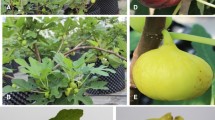Abstract
Sweet chestnut (Castanea sativa Mill.) is one of the most important species in agro-forestry and horticulture. Turkey is an important C. sativa gene centre and fruit production region. The present study aimed to measure the variations in fruit width, length, thickness and weight in four different natural C. sativa populations in Turkey and determine the loss of fruit traits due to damage by chestnut weevil (Curculio elephas (Gyllenhal, 1836)) (Coleoptera: Curculionidae). Fruits were collected from four populations (Istanbul-Bahçeköy, Çanakkale-Bayramiç, Balıkesir- Erdek and Bursa-Uludağ) of phenotypically healthy sweet chestnut trees, measurements were taken, and the fruits were classified into those damaged by C. elephas and those not. Analysis revealed significant differences among and within the populations in all fruit traits, and between the sound and damaged fruits, with the average fruit width, length, thickness and weight being 24.8 mm, 23.1 mm, 15.3 mm and 3.4 g, respectively. Bursa-Uludağ population had the highest healthy fruit ratio (70%), with some individuals in the population yielding healthy fruits at ratios > 90%. In the Balıkesir-Erdek population, however, where the percentage of damaged fruits was the highest (54%), it was determined that some trees suffered more than 90% damage in contrast to the Bursa-Uludağ population. In the fruits infested by C. elephas, the approximate percentages of loss in fruit width, length, thickness and weight were 6, 4, 7 and 30%, respectively. The fruit weight loss percentages varied between 25% and 32% among the populations.



Similar content being viewed by others
References
Altun ZG, Acar FC, Bucak C, Örtel E, Özbey AA (2018) Ege ve batı akdeniz bölgesi doğal kestane (Castanea sativa Mill.) populasyonlarında üstün ağaç seçimi [Plus tree selection in the natural population of chestnut (Castanea sativa Mill.) at Aegean and western Mediterranean region]. Aegean Forestry Research Institute, İzmir [in Turkish]
Anon (2015) Türkiye Orman Varlığı [State of Turkish Forest]. The Turkish Ministry of Forest and Water Affairs, Ankara [in Turkish]
Aslan V, Özer G, Tandoğan M, Sezgin G, Çalışkan S (2019) Marmara bölgesi doğal kestane (Castanea sativa Mill.) populasyonlarında üstün ağaç seçimi [Plus tree selection in the natural population of chestnut (Castanea sativa Mill.) at Marmara region]. Marmara Forestry Research Institute, Istanbul [in Turkish]
Bonner FT (2008) Castanea Mill. In: Bonner FT, Karrfalt RP (eds) Woody plant seed manual. United States Department of Agriculture Forest Service, Washington, pp 338-341
Çanakçıoğlu H (1969) Insect damage on cones and seeds of forest trees in Turkey. J Fac For Istanbul U Serie A XIX 2:83-90
Conedera M, Tinner W, Krebs P, de Rigo D, Caudullo G (2016) Castanea sativa in Europe: distribution, habitat, usage and threats. In: San-Miguel-Ayanz J, de Rigo D, Caudullo G, Durrant H, Mauri TA (eds) European atlas of forest tree species. EU, Luxembourg, pp 78-79
Coşkuncu KS, Mert C (2011) Studies on the infestation ratios of different chestnut cultivars in chestnut growing area of Bursa, Balikesir and Kocaeli provinces. Karaelmas Sci Eng J 1(2):31-39. https://doi.org/10.7212/zkufbd.v1i2.55
Erinç S (1965) Yağış Müessiriyeti Üzerine Bir Deneme ve Yeni Bir Indis [An essay on precipitation efficiency and a new indice]. İ. Ü. Coğrafya Fakültesi Yayınları, Istanbul [in Turkish]
Ertan E, Erdal E, Alkan G, Algül BE (2015) Effects of different postharvest storage methods on the quality traits of chestnuts (Castanea sativa Mill.). HortScience 50(4):577-581. https://doi.org/10.21273/HORTSCI.50.4.577
Ertürk Ü, Mert C, Soylu A (2006) Chemical composition of fruits of some important chestnut cultivars. Braz Arch Biol Technol 49(2):183-188. https://doi.org/10.1590/S1516-89132006000300001
FAO (2013) World food and agriculture. FAO Statistical Yearbook. http://www.fao.org/3/i3107e/i3107e.pdf. Accessed 6 Sept 2019
İpekdal K, Coşkuncu KS, Aytar F, Doğanlar M (2014) Chestnut Gall Wasp Dryocosmus kuriphilus Yasumatsu (Hymenoptera: Cynipidae): An update for its situation on the world and in Turkey and its management. Turk Bull Entomol 4(4):241-257. https://doi.org/10.16969/teb.65166
ISTA (1996) International rules for seed testing rules 1996. International Seed Testing Association, Zürich
Mattioni C, Cherubini M, Taurchini D, Villani F, Martin MA (2010) Genetic diversity in European chestnut populations. Acta Hortic 866:163-167. https://doi.org/10.17660/ActaHortic.2010.866.18
Miller G (2009) A simple chestnut peeling process and properties of the peeled kernels. Acta Hortic 844:33-40. https://doi.org/10.17660/ActaHortic.2009.844.3
Özer G (2018) İstanbul ili Anadolu kestanesi (Castanea sativa Mill.) meşcerelerinde meyve verimi ve yetişme ortamı özellikleri [Fruit yield and site characteristics of sweet chestnut (Castanea sativa Mill.) stands in Istanbul province]. Marmara Forestry Research Institute, Istanbul [in Turkish]
Özer G (2020) İstanbul ili Anadolu kestanesi (Castanea sativa Mill.) meşcerelerinde meyve verimi ve yetişme ortamı özellikleri [Fruit yield and site characteristics of sweet chestnut (Castanea sativa Mill.) stands in Istanbul province]. Dissertation, Istanbul University-Cerrahpasa [in Turkish]
Serdar Ü, Akyüz B, Ceyhan V, Hazneci K, Mert C, Er E, Uylaser V (2018) Horticultural characteristics of chestnut growing in Turkey. Erwerbs-Obstbau 60(3):239-245. https://doi.org/10.1007/s10341-017-0364-4
Soylu A (2004) Kestane yetiştiriciliği ve özellikleri [Chestnut cultivation and properties]. Hasad Yayıncılık, Istanbul [in Turkish]
TUİK (2019) Production of chestnut. https://biruni.tuik.gov.tr/medas/?kn=92&locale=tr. Accessed 14 Aug 2019
Tzortzakis N, Metzidakis I (2012) Determination of heat stress and ultra-low oxygen in chestnut storage under control and modified atmospheres. Food Nutr Sci 3:387-393. https://doi.org/10.4236/fns.2012.33055
Uylaser V, Incedayı BK, Mert C, Soylu A (2010) A research on suitability of some chestnut cultivars for candied chestnut. Acta Hortic 866:571-579.https://doi.org/10.17660/ActaHortic.2010.866.77
Acknowledgements
This study was supported by the Marmara Forestry Research Institute Directorate (Project number https://doi.org/10.1601/2015-2018). The authors are grateful to the Forest Service for their help in the field. We sincerely thank the anonymous reviewers and editor for their valuable comments and suggestions which improved the paper.
Author information
Authors and Affiliations
Corresponding author
Ethics declarations
Conflict of interest
The authors declare that they have no conflict of interest.
Rights and permissions
About this article
Cite this article
Caliskan, S., Göltaş, M., Aslan, V. et al. Variation in fruit traits and infestation ratios in natural sweet chestnut (Castanea sativa) populations under chestnut weevil (Curculio elephas) damage. Biologia 75, 2287–2294 (2020). https://doi.org/10.2478/s11756-020-00491-1
Received:
Accepted:
Published:
Issue Date:
DOI: https://doi.org/10.2478/s11756-020-00491-1




